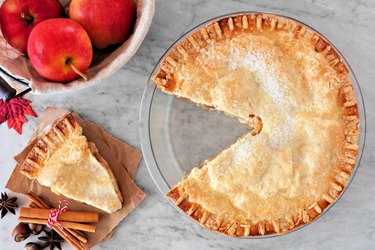
What's better than a slice of apple pie with a scoop of vanilla ice cream on top? What's more disappointing than watching a puddle of apple juice form around this piece of pie, making a soggy mess of it?
How can you be sure that your apple pie will have the strength to retain its sturdy, flaky, yummy self? How do you achieve that perfect balance between a filling that's firm without turning into glue and a crust that's as sturdy and flaky as you want? Start by considering your apples.
Video of the Day
Video of the Day
Start With the Right Apples
Fruit is juicy and some fruits more so than others. Strawberries and blackberries, for example, contain more liquid than apples do, and different varieties of apples are various levels of juicy. When making any sort of fruit pie, you'll want to think about using a thickener to avoid excess liquid.
Sweet, juicy apples may be great for snacking but will not work in pies. A lot of bakers rely on firm, tart apples for the filling, and that's fine. However, you might try combining firm-sweet and firm-tart apples for a slightly sweeter yet still firm filling. A favorite firm-tart variety for pies is the Granny Smith, or you might try the Northern Spy (called by some the ideal pie apple) if it's available in your area. The Jazz variety is a good choice for the sweet-firm component.
Alternatively, you might choose Jonagold or Pink Lady, both of which combine sweet and tart elements and can be used by themselves to fill your pie.
A Selection of Thickeners for Pie
Apples have higher levels of pectin, a natural thickener, than other fruits, so an apple pie requires less added thickener than most any other fruit pie filling, though you can't get away with skipping it altogether. Thickening agents might already be on your kitchen shelves. Regular all-purpose flour or cornstarch, for example, is acceptable to use, as are arrowroot and quick-cooking tapioca. There are also specialized products such as Instant ClearJel and Pie Filling Enhancer (both products of the King Arthur Flour Company).
How much thickener to use, then? According to King Arthur Flour, for each cup of apples in an apple pie, add either:
- 1 3/4 teaspoons of flour
- 1 1/2 teaspoons of Pie Filling Enhancer
- 3/4 teaspoon of quick-cooking tapioca
- 1/2 teaspoon of ClearJel, cornstarch or arrowroot
Thickeners: Pros and Cons
Although flour is handy and will thicken your apple pie at low temperatures, it also makes for a cloudy, somewhat gluey filling. Cornstarch is a reliable thickener, though it needs to be cooked at a higher temperature than flour and does not freeze well. If you're using cornstarch, mix it with another ingredient such as sugar before adding it in order to avoid lumps and bumps. Arrowroot also requires high heat but freezes well.
Quick-cooking tapioca is a popular thickener, but if you use it, rest the pie filling for 15 minutes or so before baking. Tapioca needs to be cooked at a low temperature and may give the filling a somewhat gluey texture.
Instant ClearJel is the choice of many commercial bakeries. It doesn't require a particular temperature range, and it freezes well. Pie Filling Enhancer is a product that combines ClearJel with superfine sugar and ascorbic acid (to brighten flavor); using it results in a pie with the same properties as one made with ClearJel.
A Few More Tips for a Fruit Pie Filling
Don't use apples past their freshness date; soft, overripe apples will make for a mushy filling. Cut your apples into thin slices; thick slices will create more air pockets in the pie where steam can collect. If you're making a lattice-topped pie, keep in mind that more moisture will be released during baking than from a double-crusted pie, and you won't need quite as much thickener.